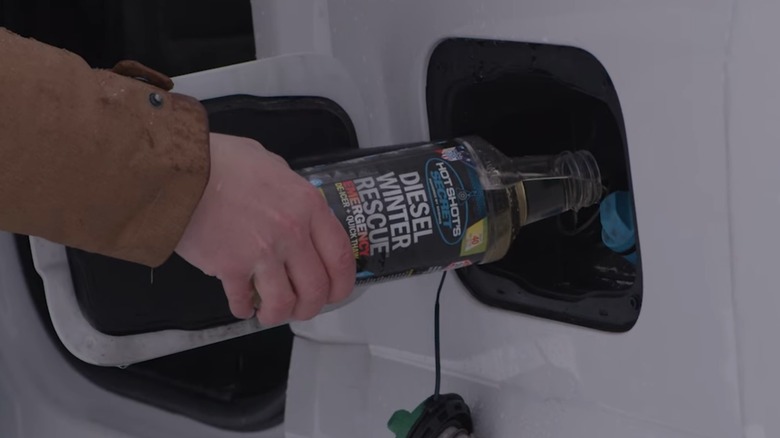2 Common Symptoms Of Gelled-Up Diesel Fuel
While diesel may not be the most popular fuel source for passenger vehicles, it's still extremely common. These engines are responsible for powering more than you may realize, and diesel motors can be found in everything from large commercial trucks and freight trains to school buses, tractors, boats, farming equipment, and more. In contrast to what many people may believe, this fuel is surprisingly efficient, and, in many cases, diesel machines can outperform gasoline engines. However, not everything about diesel fuel is good. For one, it can burn pretty dirty, resulting in the need for robust emissions control systems, like the diesel exhaust fuel (DEF) systems found on virtually every modern diesel vehicle. Another downside is diesel's tendency to gel or gunk up when the weather becomes extremely cold.
Diesel fuel gels because it contains paraffin wax particles. At extremely low temperatures, those particles can begin to stick to each other and solidify. This can start happening at around 32 degrees Fahrenheit. However, it's more likely to occur when your fuel tank is less than half full or the temperatures are extremely low — usually between 10 and 15 degrees Fahrenheit. Diesel fuel gelling isn't the most common problem, due to the extreme conditions that must be met for it to occur. However, it's still dangerous for your vehicle, and if your diesel fuel does begin to gel, your engine will likely display a couple of unpleasant symptoms. Fortunately, as a former professional auto mechanic who spent years working on both gas and diesel vehicles in the frigid Utah winters, I'll break it down for you. We'll cover everything from hard starts to performance drops, and we'll even explain what to do if your diesel fuel gels up.
Your vehicle is hard to start
When diesel fuel gels, it can clog up the entire system, including the fuel filter and the hoses that send that fuel to the engine. This can happen if you live somewhere with extremely cold winters, and the likelihood increases substantially if you leave your vehicle parked outside overnight with less than half a tank of fuel. When your fuel tank is empty, or partially empty, it's much easier for water and condensation to form, which, in turn, makes it easier for paraffin wax particles to solidify. Water alone can freeze when the temperatures drop below 32 degrees Fahrenheit, but the presence of water also lowers the freezing point of diesel fuel, intensifying the problem and making gelling much more likely to occur. If your diesel fuel does gel, clogging up the fuel system, you'll have a hard time cranking the engine. It may start very slowly, or you may be unable to fire up the engine altogether.
However, it's also important to remember that many different mechanical problems and malfunctions can make your vehicle difficult to start. Diesel engines rely on glow plugs and compression to get the combustion process going. At lower temperatures, in particular, these machines can struggle a bit more to get warmed up, which is why block heaters are so common on diesel engines. If you experience problems starting your diesel vehicle during the winter, fuel gelling may be to blame, but it could also be something else. The best way to address the problem is to visit a professional mechanic, especially if you're inexperienced with DIY auto repair.
Your engine performance drops
If your diesel fuel gels, you may not always notice the issue right away when starting the engine in the morning. If you park indoors overnight but spend most of the day working in frigid temperatures, you may notice your engine's performance begins to drop as the day wears on. This is especially likely to occur if you park and turn off the engine for a bit while the fuel tank is less than halfway full. That can allow water and condensation to begin forming, lowering the fuel's freezing point and allowing those wax particles to begin solidifying. Performance drops can take the form of various issues. Some of the problems you may experience include things like difficulty accelerating and general drops in power, like struggling to pull a work trailer up a hill. It happens because fuel is still capable of circulating through the system, but at a diminished rate, thanks to gel beginning to form inside things like the fuel lines and filter.
As mentioned, this issue is more likely to occur if you spend most of the day parked outdoors on a chilly jobsite, especially if you turn the engine off while the fuel tank is less than halfway full. However, it's worth remembering that various problems can cause your vehicle's performance to drop. If you experience this issue when the weather is more moderate or when you're sure that your fuel tank is full, you should prioritize a professional inspection.
If your diesel fuel gels, there are a couple of things you need to do
As stated above, diesel fuel gelling isn't the most common problem, due to the extreme temperatures required for the fuel to solidify. However, it can still be a dangerous condition for your diesel engine. If it happens to you, there are some steps you should take to prevent further damage.
One of the components most susceptible to diesel gelling issues is the fuel filter. This part is designed to prevent contaminants like debris and particles from making their way to your engine. When fuel begins to gel at low temperatures, the filter can quickly become clogged, preventing any remaining liquid fuel from reaching the engine. If your diesel fuel gels completely, you should replace the fuel filter as soon as possible.
You'll also need to clean any gel out of the system. That means you'll need to use a diesel fuel additive containing specially-engineered de-gelling chemicals. These products contain additives designed to break up gel, like lubricants and military-grade de-icing chemicals. Different companies produce their own de-gelling products. So, you'll need to pay close attention to the instructions when you use one. Generally, you'll need to fill your fuel tank to roughly 50% using the additive and fill the rest with quality fuel. Then, you have to crank your engine and let it run for however long the instructions specify. This allows the additive time to circulate through the fuel system and break up any gunk or gel. However, even if you do use a fuel additive, it may still be a good idea to visit a mechanic when you're able to do so. As mentioned, some of the symptoms of diesel fuel gelling can indicate other problems, so you may want a thorough inspection to rule out any other mechanical malfunctions or issues.



